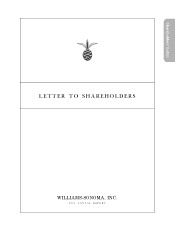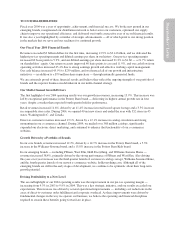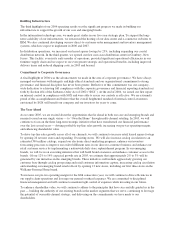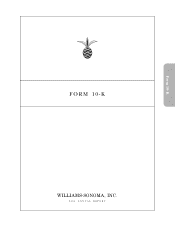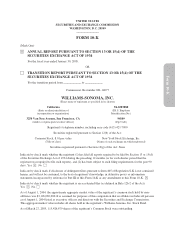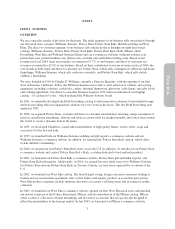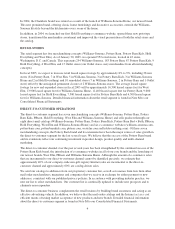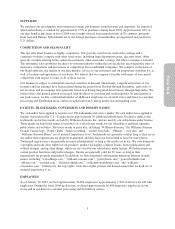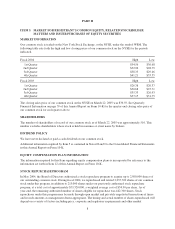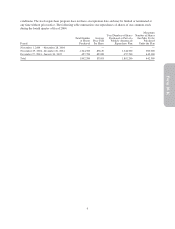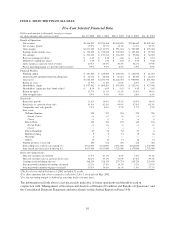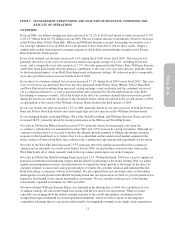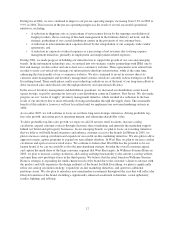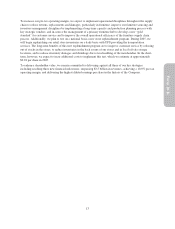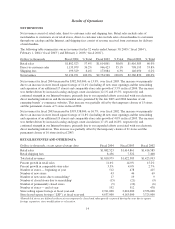Pottery Barn 2004 Annual Report Download - page 11
Download and view the complete annual report
Please find page 11 of the 2004 Pottery Barn annual report below. You can navigate through the pages in the report by either clicking on the pages listed below, or by using the keyword search tool below to find specific information within the annual report.In 2004, the Chambers brand was retired as a result of the launch of Williams-Sonoma Home, our newest brand.
This new premium brand, offering classic home furnishings and decorative accessories, extends the Williams-
Sonoma lifestyle beyond the kitchen into every room of the home.
In addition, in 2004, we launched our first Hold Everything e-commerce website, opened three new prototype
stores, transitioned the merchandise assortment and improved the visual presentation of both the retail stores and
the catalog.
RETAIL STORES
The retail segment has five merchandising concepts (Williams-Sonoma, Pottery Barn, Pottery Barn Kids, Hold
Everything and West Elm). As of January 30, 2005, we operated 552 retail stores, located in 43 states,
Washington, D.C. and Canada. This represents 254 Williams-Sonoma, 183 Pottery Barn, 87 Pottery Barn Kids, 9
Hold Everything, 4 West Elm, and 15 Outlet stores (our Outlet stores carry merchandise from all merchandising
concepts).
In fiscal 2005, we expect to increase retail leased square footage by approximately 8% to 9%, including 28 new
stores (8 in Pottery Barn, 7 in West Elm, 5 in Williams-Sonoma, 3 in Pottery Barn Kids, 3 in Williams-Sonoma
Home and 2 in Hold Everything) and 10 remodeled stores (7 in Williams-Sonoma, 2 in Pottery Barn and 1 Outlet
store) offset by the anticipated permanent closure of 2 Williams-Sonoma stores. The average leased square
footage for new and expanded stores in fiscal 2005 will be approximately 16,300 leased square feet for West
Elm, 13,900 leased square feet for Williams-Sonoma Home, 11,400 leased square feet for Pottery Barn, 9,000
leased square feet for Hold Everything, 7,300 leased square feet for Pottery Barn Kids and 6,500 leased square
feet for Williams-Sonoma. Detailed financial information about the retail segment is found in Note M to our
Consolidated Financial Statements.
DIRECT-TO-CUSTOMER OPERATIONS
The direct-to-customer segment has seven merchandising concepts (Williams-Sonoma, Pottery Barn, Pottery
Barn Kids, PBteen, Hold Everything, West Elm and Williams-Sonoma Home) and sells products through our
eight direct-mail catalogs (Williams-Sonoma, Pottery Barn, Pottery Barn Kids, Pottery Barn Bed + Bath, PBteen,
Hold Everything, West Elm and Williams-Sonoma Home) and six e-commerce websites (williams-sonoma.com,
potterybarn.com, potterybarnkids.com, pbteen.com, westelm.com and holdeverything.com). Of these seven
merchandising concepts, the Pottery Barn brand and its extensions have been the major source of sales growth in
the direct-to-customer segment for the last several years. We believe that the success of the Pottery Barn brand
and its extensions reflect our continuing investment in product design, product quality and multi-channel
marketing.
The direct-to-customer channel over the past several years has been strengthened by the continued success of the
Pottery Barn Kids brand, the introduction of e-commerce websites in all of our core brands and the launching of
our newest brands, West Elm, PBteen and Williams-Sonoma Home. Although the amount of e-commerce sales
that are incremental to our direct-to-customer channel cannot be identified precisely, we estimate that
approximately 40% of our company-wide non-gift registry Internet sales are incremental to the direct-to-
customer channel and approximately 60% are catalog-driven sales.
We send our catalogs to addresses from our proprietary customer list, as well as to names from lists from other
mail order merchandisers, magazines and companies that we receive in exchange for either payment or new
addresses, consistent with our published privacy policies. In accordance with prevailing industry practice, we
rent our list to select merchandisers. Our customer list is continually updated to include new prospects and to
eliminate non-responders.
The direct-to-customer business complements the retail business by building brand awareness and acting as an
effective advertising vehicle. In addition, we believe that the mail order catalogs and the Internet act as a cost
efficient means of testing market acceptance of new products and new brands. Detailed financial information
about the direct-to-customer segment is found in Note M to our Consolidated Financial Statements.
4


